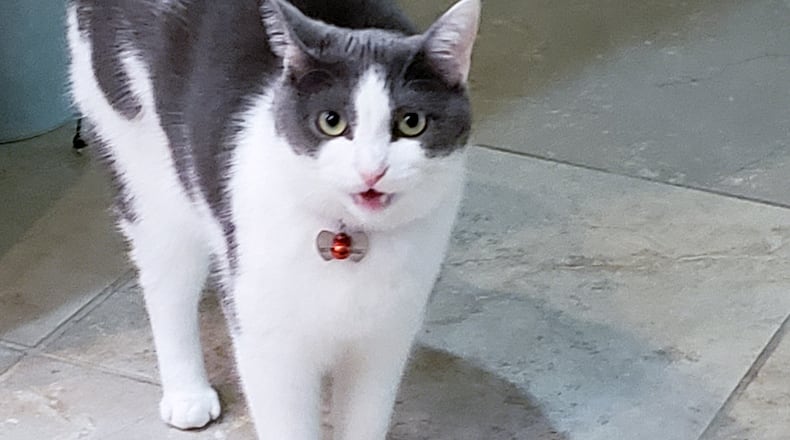“Cats use some of these methods to communicate with humans. They are adept at using body language and expressions and have been shown to recognize their owners’ emotions and respond appropriately.”
Youens believes that when I learn more about how Pip talks, I can understand more about him and possibly get him to understand what I’m asking him.
Over the last five years, I’ve learned that when Pip starts to meow loudly, he wants to be fed. If it’s a little early for lunch or dinner, I will ignore those “meows.” Not to be deterred, Pip meows more loudly and taps my arms or back with his front paws to make sure I’m paying attention. When Pip starts to interrupt what I’m doing, like walking across or sitting on my computer keyboard when I’m typing or plopping in the middle of a basket of clean clothes, preventing me from putting them away, his communication strategies carry the day and he gets fed.
The kibble cruncher has learned the meaning of several words and responds accordingly. When I say “Treat,” he has learned to follow me and he’ll receive a few pieces of his tasty kibble. But if I ask Pip, “Lunch,” or “Dinner,” he runs to his food mat and waits for me to fill it up.
Michelle Gunter at catster.com says communicating with your cat can make the feline feel understood, strengthen his bond with you, decrease loneliness and stimulate learning. It also may help alert you when your cat is sick.
Pip is my family’s third and most vocal cat. One of the big differences between the three is how much more we talk to Pip than we did the other two. It’s not that we ignored Bailey or Abby, but we do make a conscious effort to talk to Pip.
In turn, Pip talks much more to us. We know when he wants more food or is irritated by his weekly brushing, all by the tone and volume of his “meows.”
According to Pip’s vocalizations and movements, I’m his go-to-human. On the first day he joined our family, he climbed into my lap, meowed loudly as if to introduce himself, then curled up and stayed until he was ready to explore the rest of the house.
Often now, when I’m at my desk working, Pip lies next to my computer watching me type. I’ll talk to him about what I’m working on and ask him what he thinks.
Gunter writes, “Cats want to bond with their owners. If you take the time to communicate with them in soft, calming tones, that bond will strengthen faster. Your tone and the affection you offer during these periods can help show your cat that you love them and want to spend time with them.”
All our cats have used their “meows” to signal loneliness. Most cat owners know that sound and/or movement. Bailey would look for me and then follow me from room to room. Abby would “meow” loudly. Pip’s meows are piercing. He jumps in my lap or moves to a room to join his family.
“The more the two of you communicate, the more you’ll recognize your kitty’s normal reactions,” Gunter points out. “This is a great tool if your cat is feeling under the weather. Often, when a cat is sick, its meows will be meek or noticeably different. You can pick up on this and get the treatments they may require from the veterinarian.”
With Bailey, we were so new to cat ownership that we probably missed a few signs when she wasn’t feeling well. After Bailey, we were much more alert.
Gunter added, “Talking to your cat and letting them hear your voice is a great way to form a bond with even the most stubborn kitty.”
From Bailey to Abby and now Pip, I’ve seen the results of engaging our cats through communicative behaviors.
Pip has just now climbed up on a shelf over my laptop and is gently swatting my head. He’s softly meowing. From past encounters, I believe he’s saying, “I’m here, play with me, I’m bored.”
So I’m turning off the laptop and grabbing his catnip-filled mouse wand. It’s his current favorite. Soon he’ll be hungry, but I’m sure he’ll let me know.
Karin Spicer is a member of The Dog Writers Association of America and The Cat Writer’s Association. She livers with her family and two furry pets who inspire her. She can be reached at spicerkarin@gmail.com.
Cats’ 4 major expressions
1. Greetings
2. Irritation
3. Confusion
4. Embarrassment
About the Author

